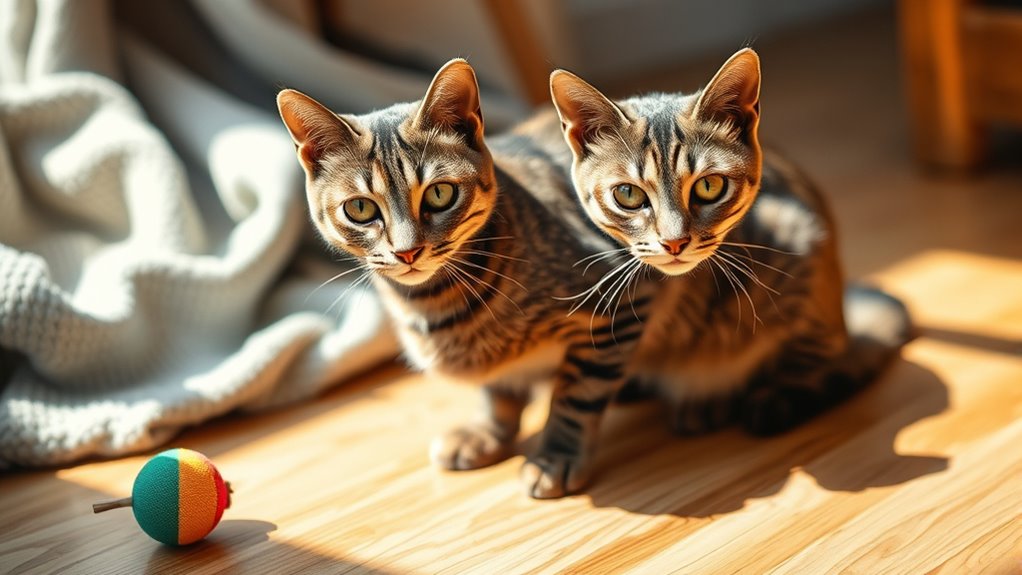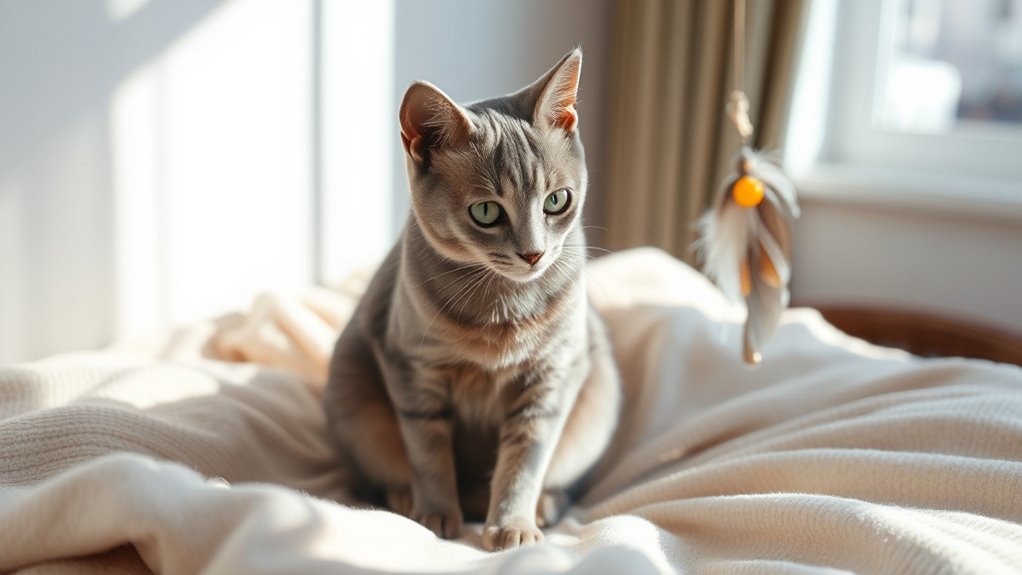To find out if your cat is left-pawed, observe their behavior during everyday activities, like reaching for treats or batting at toys. Notice which paw they use first or more often, and repeat this over several days to guarantee consistency. If they consistently favor the left paw, they might be left-pawed. Keep watching their habits, and if you want to learn more about interpreting the results, there’s a simple test you can try.
Key Takeaways
- Observe which paw your cat uses first when reaching for treats or toys placed just out of reach.
- Conduct multiple sessions to ensure consistent paw preference before drawing conclusions.
- Watch whether your cat favors the left paw during activities like batting or pawing at objects.
- Consistent use of the same paw across different tests indicates paw dominance, such as being left-pawed.
- Repeating simple at-home tests helps determine if your cat is left-pawed, ambidextrous, or shows no clear preference.

Many cat owners wonder whether their feline prefers using one paw over the other, and discovering your cat’s dominant paw can be surprisingly simple. Paw dominance is a natural trait, much like handedness in humans, and it can reveal interesting aspects of your cat’s personality. To determine if your cat is left-pawed, you don’t need fancy equipment—just a little patience and a straightforward at-home test. Recognizing paw dominance can also help you tailor your training techniques, making your interactions more effective and enjoyable.
Start by observing your cat in everyday situations. For example, place a treat or toy just out of reach and see which paw they use to reach or paw at it first. Do they extend their left paw more often than the right? Repeat this several times over a few days to get consistent results. When your cat reaches for something, pay close attention to which paw they favor. Keep in mind that paw preference might not be obvious immediately, so patience is key. Consistency in their choice indicates true paw dominance rather than occasional use.
Another simple test involves encouraging your cat to perform a task, such as batting at a dangling toy or pushing a button to get a treat. Watch carefully which paw they naturally use during the activity. If they consistently use their left paw, it’s a sign of left-pawed dominance. If they alternate or show no clear preference, they might be ambidextrous or have less pronounced paw dominance. Making these observations over multiple sessions ensures accuracy, helping you better understand your cat’s behavioral tendencies. Understanding paws dominance can also enrich your overall knowledge of feline behavior and preferences.
Knowing whether your cat is left-pawed can also influence your training techniques. For example, if your cat favors their left paw, you might adjust your approach to reinforce positive behaviors using that side. This awareness can improve your communication, making training sessions more successful. Plus, understanding paw dominance can deepen your bond, as you become more attuned to your cat’s unique preferences and habits.
Frequently Asked Questions
How Accurate Is the At-Home Test for Determining Paw Dominance?
The at-home test for determining your cat’s paw preference offers a fun way to observe behavior, but its test reliability isn’t perfect. It can give you a good idea of which paw your cat favors, yet individual variability means results might not be 100% accurate. To get a clearer picture, try the test multiple times over several days, and watch for consistent paw preference to confidently assess your cat’s paw dominance.
Can a Cat Switch Paw Preference Over Time?
Paw preference, like personality, can change over time. You might notice your cat switching paws, especially as behavioral indicators evolve with age, environment, or experience. While some cats have a dominant paw, others may shuffle or show signs of switching paws. Keep observing your feline’s actions; flexibility in paw preference isn’t uncommon. So, yes, your cat can switch paw preference, reflecting natural shifts and subtle social signals.
Does Paw Dominance Indicate a Cat’S Personality Traits?
Paw dominance doesn’t necessarily reveal your cat’s personality traits, but it can give some insight into their paw behavior. You might notice that a left-pawed or right-pawed cat shows specific tendencies, like being more cautious or confident. While there’s a slight personality correlation, it’s not definitive. Your cat’s overall behavior, social interactions, and environment play a bigger role in shaping their unique personality beyond just paw preference.
Are There Health Implications Related to a Cat Being Left-Pawed?
You might wonder if pawedness impacts your cat’s health. While pawedness development reflects feline behavioral health, current research shows no direct health risks linked to being left-pawed. However, observing your cat’s paw preference can help identify subtle signs of discomfort or injury. Regularly monitoring their pawedness offers insights into their well-being, allowing you to address potential issues early and support their overall health and happiness.
How Early Can a Kitten Show Paw Preference?
Did you know that studies show about 40% of cats show paw preference by three months old? You might notice a kitten favoring one paw as early as 8 weeks, but full paw preference development can take longer, usually around 6 months. During this time, feline behavior reveals subtle clues, helping you understand your kitten’s personality and possibly predicting their later paw dominance.
Conclusion
So, give this simple test a try and see if your cat favors its left paw. Did you know that around 40% of cats are left-pawed, similar to humans? Recognizing your cat’s dominant paw can deepen your bond and help you understand their behavior better. It’s a quick, fun way to learn more about your feline friend without any special tools. Who knew that such a tiny test could reveal so much about your cat’s personality?










